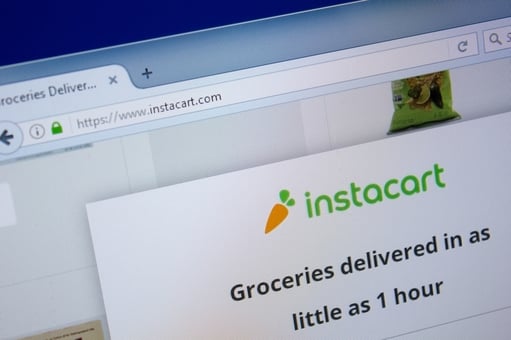Anyone invested in consumer packaged goods has certainly noticed one particular area of eCommerce that has exploded in growth over the past couple of years: groceries. If you remember from our 2020 blog, the rate of online grocery sales skyrocketed ever since the beginning of the pandemic.
This trend still holds true in 2022, as new Mercatus research projects grocery eCommerce to increase to 21.5% by the year 2025. One of the biggest players in this arena is Instacart, with an increasing number of brands hopping on this platform to take advantage of increased awareness and sales.
It’s time to devise a new Instacart strategy to compete with new brands while keeping up with Instacart’s growth in 2022. Read on to get Bobsled advertising expert Matteo Bizon’s insights on the fundamental aspects of marketing and selling your products on Instacart in 2022 along with some tips on how to improve your performance. Find out why we continue to make it on the Inc. 5000 list as eCommerce sellers continue to sign up for our unique omnichannel method of success.

The Status of Instacart in 2022
Compared to Instacart in 2021, the level of competition has increased even more significantly than before. While it’s no secret that COVID-19 has directly contributed to the rise of online grocery orders, Instacart popularity continues to grow because more and more brands are adding it to their omnichannel approach.
There are benefits and consequences to this, of course. One of the biggest drawbacks to the status of Instacart in 2022 is a diluted presence for brands in terms of organic search results. But on the other side of the coin, there are higher cost-per-click values which can result in increased profits as long as ad spending is properly optimized.
It’s important to reassess your brand’s relationship with Instacart and consider whether you want this platform to be one of the biggest players in your business.
Instacart Advertising
Advertising on Instacart has been made extremely user-friendly since the company introduced its self-serve advertising platform. The main ad type, Featured Products, allows brands to promote their listings in several different places on Instacart. Some of the best products will show up in relevant areas such as search results to “related products” widgets on different pages.
This platform is powerful in that it allows advertisers to create campaigns containing different ad groups, each of which is associated with specific products and bid levels. Consequently, you can segment how aggressively to bid on specific keywords or placements based on the product line. You can also tweak ad campaigns to be in line with your specific brand goals.
CPC Values and ROAS Campaigns
In 2022, CPC values are very likely to increase. Because of this, a holistic approach will be needed to deliver high ROAS campaigns. Brands will need to:
- Perform regular bid optimization to boost well-performing keywords and limit non-performing ones
- Limit the reach of irrelevant and automatically-seeded keywords by setting low bids
- Make the most of automatic placements, which in certain conditions allow for a great ROAS
- Focus on conversion rate improvement to make the most of each paid click
Want to learn more about growing the best ROAS (Return On Ad Spending)? Revisit our pandemic-era DSP advice with COVID-19: Utilizing Amazon DSP to Drive Growth!
Display Advertising
In late 2021, Instacart introduced a new ad type: Display Advertising. It consists of a banner that shows up based on your specific keyword or audience targeting goals. When clicked, the banner leads to a landing page with all of your brand’s products.
This differs from Featured Products because it runs on a CPM model, meaning the advertiser pays on a per-impression basis rather than per-click. There are some advantages and disadvantages related to Display Advertising that can help you form a smart strategy for future advertising on Instacart.
The Pros of Display Advertising
The most positive aspect of Display Advertising is that it allows you to target specific audiences. You can pinpoint people who shop in certain aisles, categories, or brands at the grocery store. This goes beyond simple targeting options based on keywords.
In addition, this is placed at the top of the page - it even goes above Featured Products and organic search results! This makes it a great tool for brands to use when trying to increase visibility and awareness.
The Cons of Display Advertising
One drawback Bobsled has detected so far with this Instacart’s Display Advertising is that average bids are extremely high and competitive. While visibility is great, your ROAS might not be as strong as you’d like it to be. Moreover, ROAS reporting is a different process than it is in Featured Products. A sale is attributed after an ad click for Featured Products, but for Display Advertising, the sale might be attributed after a click or a view of the banner. This does not give enough room for an equal comparison.
If your brand is looking for more visibility, Display Advertising is still a great tool to leverage. Otherwise, a focus on Featured Products might have a stronger impact on overall sales.
Organic Marketing on Instacart
Organic sales, those that come from search results that aren’t being sponsored by ads or campaigns, drive a significant portion of revenue for brands on Instacart. So folding an organic marketing strategy into your overall game plan is critical for growth.
Each search engine ranks the results of a user query based on different parameters. As an example, Google’s search engine typically rates the quality of the content along with the number of references a website receives from other sites in order to rank search results. Amazon’s search engine is similar; it takes into account the number of reviews and sales velocity along with the quality of content rated on its site.
Bobsled’s Recommendation
Internal Bobsled research has shown that there is virtually no correlation between the organic ranking of a product on Instacart and the quality of that product’s description or the number of images it has. This leads to the hypothesis that Instacart’s ranking system values other parameters much more highly than listing quality, such as basket penetration (the number of times a certain item has gone into people’s shopping carts).
At the same time, there are still several things that a brand can do to increase its overall conversion rate. Bobsled’s recommendation is to always make use of the available characters for a description as well as the available number of images, no matter what.
These elements may not be fundamental in determining the ranking of a product directly, but they may help increase their conversion rate, which indirectly improves your rankings. Brands should also be sure that product titles contain relevant keywords and high-quality images with precise descriptions to boost click-through rates.
Solidify Your Instacart Strategy for a Strong Omnichannel Brand in 2022!
Every aspect of your marketing strategy is important when it comes to forming a solid Instacart strategy in 2022. While the display advertising and keyword ranking systems are different from those on Amazon, some best practices still ring true, regardless of the marketplace. Leveraging all of the platform's tools, both on the paid and organic marketing front, to showcase your brand and products will help you stand out from the competition.
Need help navigating Instacart and other eCommerce marketplaces?
Book a free consultation with one of our experts today!

Tagged: Grocery & Gourmet Food, Instacart
.png)


